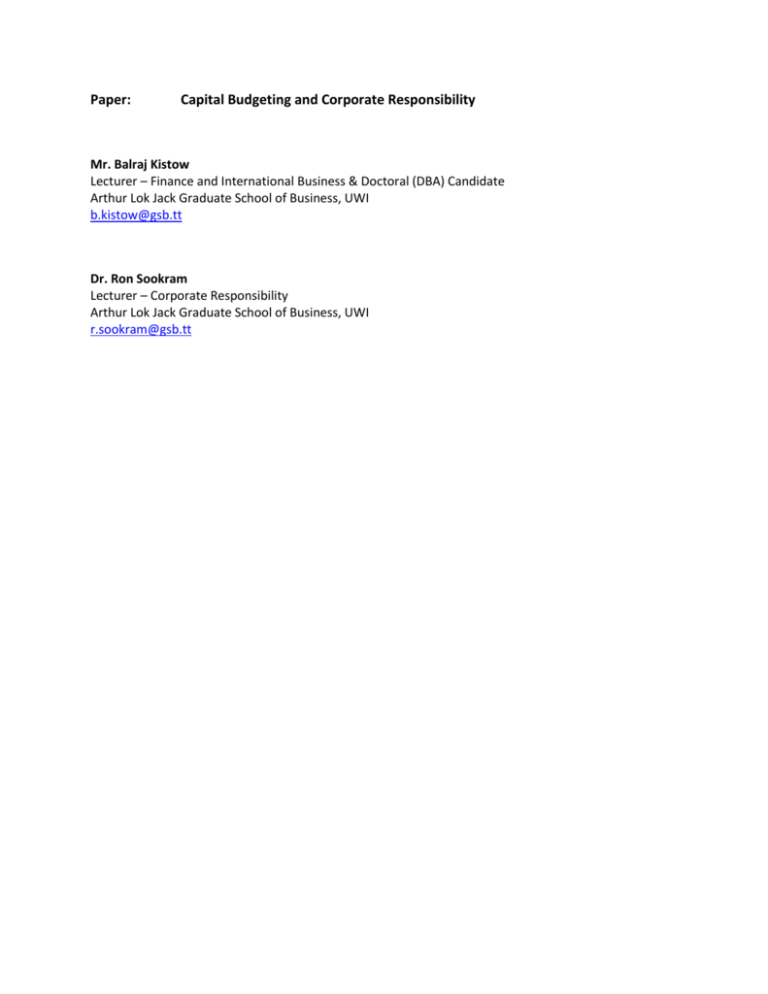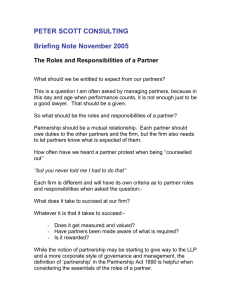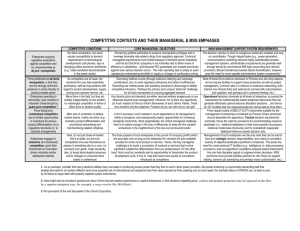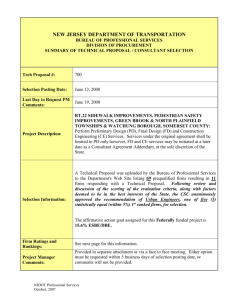
Paper:
Capital Budgeting and Corporate Responsibility
Mr. Balraj Kistow
Lecturer – Finance and International Business & Doctoral (DBA) Candidate
Arthur Lok Jack Graduate School of Business, UWI
b.kistow@gsb.tt
Dr. Ron Sookram
Lecturer – Corporate Responsibility
Arthur Lok Jack Graduate School of Business, UWI
r.sookram@gsb.tt
Paper title: Capital Budgeting and Corporate Responsibility
Abstract
Globally, business is being viewed as a major cause of the social, environmental and economic problems
plaguing our societies. The increase in the scale of these problems has led to numerous questions and
suggestions about the role and responsibilities of business in society with a universal call from a wide
range of stakeholders for corporations to play a greater role in mitigating or solving these problems.
Emerging from these issues are new paradigms intended to redefine the purpose of business in society
with advance methods of measuring firms’ performance that includes social, environmental, and
economic performance which depart from the traditional financial and cost accounting systems that
treat mainly with reporting economic performance as reflected in profits. It is in this context that this
paper assesses the extent to which firms in Trinidad and Tobago incorporate social and environmental
factors into their capital budgeting practices and so provides valuable insights into the level of
sustainable practices in the corporate landscape of the country. The discussion is placed within the
sustainable development framework and the development of sustainable enterprises.
Introduction
Globally, business is being viewed as a major cause of the social, environmental and economic problems
plaguing our societies. The increase in the scale of these problems has led to numerous questions and
suggestions about the role and responsibilities of business in society with a universal call from a wide
range of stakeholders for corporations to play a greater role in mitigating or solving these problems. This
responsibility was made even more specific with the United Nations’ Global Compact which aims to
make it possible for companies all over the world to participate in and contribute to tackling various
socio-economic problems such as human rights, labour exploitation, the environment and corruption, as
outlined in its 10 principles (Kanji & Chopra, 2010). It is also clear that planetary survival depends on
resolving these problems but this is possible only with significant active participation of the private
sector.
2
This new role, that society expects business to play, further underscores the complexity of the
relationship between business and society, and intensifies the ongoing battle between maximizing
shareholder value and providing benefits to the wider society (Haugh and Talwar 2010). Emerging from
these issues are new paradigms intended to redefine the purpose of business in society with advance
methods of measuring firms’ performance that includes social, environmental, and economic
performance (Brown et al, 2006). Among these is the notion of “Triple Bottom Line” (3BL) accounting
which measures a corporation’s success not just by the traditional financial bottom line, but also by its
social/ethical and environmental performance (Norman and MacDonald 2004). It is in this context that
capital budgeting can arguably contribute to mitigating some of these socio-economic problems. How
capital budgeting can contribute to mitigation is thus the focus of this paper. The discussion however is
placed within the framework of sustainable development and the development of sustainable
enterprises.
Enterprises, irrespective of size, are the principal source of economic growth and employment creation
and are at the center of economic activity and development in nearly all societies. They are vital
stimulants that bring about change and progress by ensuring that economies remain dynamic,
innovative and competitive (Baumol, 2002). Given their central role in wealth creation and
development, enterprises need to therefore ensure that their core business activities continue to add
value and are undertaken efficiently and effectively (Buckley, Salazar-Xirinachs & Henriques, 2009). This
is the basis in which the concept sustainable enterprise is introduced. It is directly linked to the general
approach to sustainable development articulated by the World Business Council for Sustainable
Development (WBVSD) as “forms of progress that meet the needs of the present without compromising
the ability of future generations to meet their needs” (WBCSD). This approach to development is
3
holistic, balanced and integrated requiring the integration of all three pillars of development: economic
growth, social progress and environmental issues.
Thus unlike the traditional perspectives which view enterprises in terms of linear input-output
relationships focused solely on maximizing short-term economic value, an integrated approach to
sustainable enterprise takes a more holistic, integrated and long-term view. Such enterprises are
economic entities pursuing profit through fair competition but are simultaneously socially useful
contributing to social development by providing goods and services created according to ethical
principles. A sustainable enterprise therefore has an advanced awareness of the close link between
social and corporate development and are expected to create a sustainable society through business
activities that comprehensively reflects economic, environmental and social issues (Buckley, SalazarXirinachs & Henriques, 2009). This holistic and integrated approach can therefore be incorporated into
capital budgeting.
Measuring Economic Performance
Organizations use accounting systems as their main measure of financial performance. The accounting
system collects and aggregates financial information for use by internal and external decision makers
such as managers, investors, regulators, lenders, bankers and the public at large. Schempf (1998)
contends that accounting systems influence behavior and so affects management across departments,
organizations, and even countries. Accounting information systems are particularly strong behavioral
drivers especially where profits and the bottom line are of major importance. If environmental and
social issues are considered critical factors in everyday business management decisions, they then need
to be incorporated into the accounting systems of organizations (Schempf, 1998).
4
As mentioned earlier, traditional financial and cost accounting systems are designed to treat mainly with
reporting economic performance. Given the urgent call for sustainable development and sustainable
enterprises companies need to include social and environmental measurements when assessing their
performance. Nonetheless, while social and environmental information might be available to some
organizations there are still challenges in effectively linking such information to economic variables (UN
Division for Sustainable Development, 2001). Consequently, the economic value of natural and social
resources as assets is largely ignored. According to Hawken et.al (1999):
Capitalism, as practiced is a financially profitability, aberration in human
development… It neglects to assign any value to the largest stock of capital it
employs – the natural resources and living systems, as well as the social and
cultural systems that are the basis of human development.
Arguably, capitalism has contributed to the socio-economic crises facing our societies consequently
increasing the pressure for the corporate sector to be more socially and environmentally responsible
(Drucker, 1955, Shopp, 2005, & Savitz, 2006). Businesses would need to find feasible methods to
incorporate techniques and practices that account for the social and environmental costs of their
decisions.
Capital Budgeting
The chief determinant of what a company will become is the investment it makes today (Higgins, 1998).
As companies seek to maximize its shareholder value through its economic performance it must manage
its inputs in order to optimize its outputs. This requires decision makers to carefully evaluate how best
to invest its resources. A company would want to list the projects and investments it wishes to
undertake and decide on which it would accept through a process of capital budgeting (Beck &
DeMarzo, 2009).
As such capital budgeting is a critical component in a company’s bid to stay
5
competitive, viable and sustainable, as it helps to inform the pivotal financial decisions that will optimize
corporate resources in the long run.
The traditional quantitative methods for assessing capital projects involve comparing the cash inflows
and outflows so as to determine the overall net cash position from undertaking the project. The most
common methods used are:
1. The Payback Period – this method calculated the time taken for the initial capital outlay to be
recouped by the investor. Where the cash inflows are discounted at the cost of capital, it is
called a discounted payback.
2. Net Present Value (NPV) – this method compares the discounted cash inflows with the cash
outflows for the project. The factor used to discount the cash flows is the cost of capital. A
project is considered favourable if the discounted cash inflows exceed the cash outflow.
3. Internal Rate of Return (IRR) – This is the discount rate at which the NPV is rendered to be zero.
A project is said to be favourable if the IRR exceeds the company’s required rate of return or
hurdle rate.
4. Breakeven Analysis – This is usually used as complementary to the above methods and used
mainly to test the sensitivity of certain variables in the project. The idea is to determine the
level of sales required before the company would generate a net income.
While these methods are very useful in assessing the economic viability of a project from the
perspective of the financiers, they are weak in assessing the social and environmental cost/impact of the
project. These conventional cost accounting techniques, aggregate environmental and nonenvironmental costs in overhead accounts, resulting in them being “hidden” from management.
Decision-makers are thus unable to adequately appreciate the significance or value of these nonfinancial variables with these conventional methods. In fact, there is substantial evidence that
management tends to underestimate the extent and growth of such costs (United Nations Division of
Sustainable Development, 2001). Ditz et. al (1995) estimates that environmental cost can range from
between five to twenty five percent of the total cost of business activities. These costs are likely to rise
6
as pressure for environmental protection increases. As such, incorporating environmental cost directly
into accounting systems and business strategies can enhance a firm’s competitive position (Gale &
Stokoe, 2000).
A report compiled by White et al (1995) for the US Environmental Protection Agency revealed that
environmental costs, often considered in the financial evaluation of a project, are those that are tangible
and
quantifiable,
such
as
hazardous
waste
testing/monitoring,
on-site
wastewater
pretreatment/treatment/disposal and on-site hazardous waste pre-treatment /treatment/disposal. On
the other hand, the environmental costs least frequently considered in project financial evaluation
include environmental fines and penalties, corporate image, insurance costs, personal injury claims,
marketable by-products, natural resources damage costs, legal staff time, and sales of environmentally
friendly/green products. These costs are generally perceived as less tangible, contingent, and difficult to
quantify. The study also noted that in 70% of the firms surveyed, once the costs were quantified it was
included in financial assessments (White et. al, 2000).
From the perspective of internal and external costs, the less tangible cost tends to be the external cost,
while the more tangible and quantifiable costs are the internal cost. The methods mentioned above for
project appraisal are very much biased towards the inclusion of internal cost, as these represent the
monetized cost to the financiers.
Since external costs do not readily and directly affect the cash flow
they are less likely to be considered. Economists refer to these external costs as externalities as these
costs are incurred by society as a whole but not factored into the cost based value of the product. These
external costs that firms impose on society must therefore be factored in profitability calculations and
considered in the decision making process. This process of making external cost to bear on private or
7
internal cost is referred to as internalizing an externality. Not only do these ensure the future viability
of the firm through more comprehensive assessment of liabilities and risks, it also informs stakeholders
of potential health and environmental costs from the organization’s economic activities (Gale & Stokoe,
2000).
Savitz (2006) explains that increasingly, businesses are expected to find ways to be part of the solution
to the world’s environmental and social problems. To partially achieve this requires adopting techniques
and policies that incorporate both internal and external costs. Some of these newer techniques would
include Environmental Impact Assessments (EIA), Life Cycle Assessment (LCA), Full Cost Accounting and
Environmental Cost/Benefit Analysis, Triple Bottom Line (TBL).
The Study
Trinidad and Tobago is the most southerly island of the Caribbean chain. Since the early 1990s, this twin
island republic has experienced steady economic growth based on its natural resources in oil and gas.
With an energy driven economy there are major investments in downstream industries, especially
through inward FDI, such as Liquefied Natural Gas, Methanol, Ammonia and Urea. The country also has
the leading manufacturing sector in the English speaking Caribbean and is also a major exporter to the
region.
The relatively large quantity of heavy industry has made the country one of the largest emitters of
carbon dioxide per capital in the world. The 2010/11 WEF Travel and Tourism Competitiveness Report
ranked the country 137 out of 139 for environmental sustainability and 133 out of 139 for carbon
dioxide emissions. Given this record and the ever increasing pressure locally and globally to engender
8
sustainable practices, firms in Trinidad and Tobago would need to become more conscious of their
environmental footprint.
This study aims to determine the techniques employed to evaluate capital projects among firms in
Trinidad and Tobago. The study also seeks to ascertain the extent to which firms consider responsible
corporate citizenship in evaluating the impact of capital investments. A survey instrument was
administered to 126 randomly selected firms over a one month period (March –April 2010). Three
questionnaires were rejected due to missing data. The remaining 123 questionnaires were coded and
analyzed using SPSS.
Findings and Analysis
Of the firms surveyed, 66% belonged to the Services sector while 34% were in Manufacturing. Firms in
the Services sector were involved mainly in finance, construction, retail and distribution services. The
firms in Manufacturing were in the energy sector as well as heavy and light manufacturing. Regarding
years of operations, 31% were in operation for less than ten years while 33% were in operation between
10 – 30 years and 36% over 30 years. The majority (89%) was indigenous to Trinidad and Tobago while
11% was affiliated to multinational corporations.
In terms of firm size, 38% had revenues of less than US$5 million, 30% between US$5 – US$25 million
and 32% had revenues in excess of US$25 million. Also, 42% had less than 100 employees while 37%
had between 100–500 employees and 21% had over 500. Over the last 3 years (2008-2011), half of the
firms had capital spending of less than US$1 million while 23% had capital expenditure between US$1–5
million and 27% had capital spending in excess of US$5 million.
9
With respect to assessing capital spending, firms generally utilized more than one method of
assessment. The use of quantitative evaluating techniques was very widespread. As seen from Figure 1,
the most popular methods for assessing capital projects were Net Present Value (NPV), Payback and
Internal Rate of Return (IRR). Qualitative methods such as Intuition and Executive Opinion Surveys were
less used. Intuition was popular among firms that had one or two persons responsible for making the
key business decisions. This was evident in family run businesses, for example. However in many of the
cases three evaluating methods were employed when there was more than one competing project.
Figure 1 – Use of Conventional Capital Apprasial Techniques
The persons or groups responsible for making the final decision to accept or reject capital projects
varied. On one hand, 49% of the companies gave this responsibility to the Board of Directors compared
to 32% where the CEO/Managing Director made such decisions. On the other hand, 8% of the
companies indicated that the owner or controlling family made this decision compared to 11% where a
team of executives was given this task.
10
Consistant with the methods of analysis, the factors considered most important when assessing capital
projects were largely related to their financial and operational viability. Net cash flow, cost of capital and
working capital requirements were considered most important in assessing capial projects (Figure 2).
Interestingly, these factors are also the critical variables when conducting NPV and IRR analysis.
Figure 2 – Factors Considered Important for Apprasing Capital Projects
While 97% of the companies considered themselves to be responsible corporate citizens, less than 30%
attempted to determine the environemntal and employment impacts/costs of their capital projects.
11
Figure 3 – Use of Methods that Measures Social and Environmental Impact
As indicated in Figure 4 above, firms that employed methods and techniques that were consistent with
measuring social and environmental impacts of projects were in the minority.
Environmental
Cost/Benefit Analysis and Environmental Impact Assessment were conducted in 35% and 33% of the
cases respectively.
In many of these cases they were done to satisfy statutory requirements.
Interestingly, responsible corporate citizenship was considered by 35% of the firms while 27% utilized
life cycle analysis techniques. It must be pointed out that many companies were either unaware of these
methods or had little idea of how they can be implemented.
For further insights into firms’ commitment to responsible corporate citizenship, respondents were
asked to indicate whether they would still undertake projects under the circumstances outlined in Figure
4. Eleven percent (11%) of the companies indicated that they would still undertake projects despite a
high probability of being fined for environmental damages. Thirteen percent (13%) indicated that they
would proceed with a project knowing that it would negatively affect the natural environment and 8%
12
claimed that the project would be approved knowing it would have a negative impact on the firm’s
image.
Figure 4 – Would Your Firm Undertake a Project if these Factors Exist?
While there was no significant co-relation between firm size measured in terms of revenue and the
questions asked in Figure 4, the vast majority (90%) of the firms, answering in the positive to the
questions, were locally owned and not a part of any multinational corporations. This suggests that local
firms are lagging behind in their corporate responsibility practices. The multinational firms whose
headquarters are largely based in the developed countries seem to be imposing its global responsibility
standards on the local affiliates making them more in line with acceptable corporate responsibility
practices and expectations. It must also be noted that whilst the vast majority of the firms said that they
comply with social and environmental expectations there were at least 16 companies, half of which had
capital investments in excess of US$15 million over the last 5 years, who were willing to undertake
projects regardless of negative impacts on the environment.
13
Firms in Trinidad and Tobago therefore need to reassess their methods of evaluating capital projects if
they are to become sustainable enterprises. Capital projects are assessed using mainly NPV, Payback
and IRR methods. This is consistent with what firms identified as their critical success indicators being
cash flow, cost of capital and working capital. These methods when applied focus on internal costs and
largely ignore external costs. Methods such as EIA, life cycle analysis and cost/benefit analysis, which
are more akin to incorporating external costs are not very popular tools for capital budgeting. In
general, companies in Trinidad & Tobago employ mainly traditional financial and accounting methods
and are yet to embrace an advanced awareness of the close link between social and corporate
development. On the basis of the definition of sustainable enterprises, it can be argued that there are
few such companies in Trinidad, because a holistic and integrated approach, that incorporates
economic, environmental and social issues into capital budgeting, is limited. It also points to the need
for stronger practices of corporate governance because sound corporate governance, which is integral
for creating sustainable enterprises, recommends that the company provides an assurance to
stakeholders that it manages its impact on the environment and society in a responsible manner.
Conclusion
Becoming a sustainable enterprise requires a philosophical shift in the firm’s methods of measuring
success.
Sustainability requires success to be measured in a holistic manner that gives due
consideration to an organization’s social, environmental and economic responsibilities. Capital spending
can determine a firm’s value and future. Therefore the methods used to assess capital projects are
critical. The findings of the study suggest that if firms in Trinidad & Tobago are to become sustainable
enterprises they would need to adopt assessment methods that are more akin to incorporating internal
as well as external costs. There are firms that are willing to ignore environmental and social concerns in
the planning of capital projects, however, as the demand increases for companies to be more
14
responsible ignoring these issues could have serious financial and market implications. It is therefore
imperative that firms make the ideological shift to becoming sustainable in a holistic manner.
15
References
Baumol, W.J. (2002) The Free market innovation machine: Analyzing the growth miracle of
capitalism, Princeton, University Press Princeton
Beck, J and De Marzo. (2009). Corporate Finance: The Core. Pearson Prentice Hall, Boston.
Brown J and Fraser M (2006) “Approaches and Perspectives in Social and Environmental
Accounting: an Overview of the Conceptual Landscape,” Business Strategy and the Environment,
15, 103-117.
Buckley, Graeme, Salazar-Xirinachs, J, Henriques, M (2009), The Promotion of Sustainable
Enterprises, Geneva, International Labour Office.
Ditz, Daryl, Janet Ranganathan and R. Darryl Banks, eds. (1995) Green Ledgers: Case Studies of
Corporate Environmental Accounting. World Resources Institute. May.
Drucker. P. (1955). The Practice of Management. Butterworth-Heinemann. pp. 375
Gale, R. and Stokoe, P. (2001). Environmental Cost Accounting and Business Strategy. In Chris
Madu (Ed.) Handbook of Environmentally Conscious Manufacturing. Kulwer Academic
Publishers
Hawken, P. Lovins, A and Lovins, L. (1999). Natural Capitalism: Creating the Next Industrial
Revolution. Little Brown & Company, New York.
Haugh, H. and Talwar, A. (2010). How Organization Embed Sustainability Across the
Organization. Academy of Management Learning and Education. Volume 9 Number 3. pp. 384 –
96.
Higgins, R. (1998). Analysis for Financial Management. 5th ed. McGraw Hill/Irwin, Boston.
Kanji, V. and Chopra, P. (2010). Corporate social responsibility in a global economy. Total Quality
Management & Business Excellence, Volume 21 Issue 2 (February). pp. 119-143.
Norman Wayne and MacDonald, Chris (2004), “Getting to the Bottom of ‘Triple Bottom Line’”,
Business Ethics Quarterly, Vol. 14 No. 2, pp 243-262
Shoop, M. (2005). Corporate Social Responsibility and the Enviroment : Our Common Future. . In
Mullerat ,R. ed. (2005). Corporate Social Responsibility: The Corporate Governenace of the 21st
Century. Kluwer Law International. pp 97 - 112.
Savitz, A and Weber, K. (2006). The Triple Bottom Line: How Today's Best-Run Companies Are
Achieving Economic, Social, and Environmental Success — and How You Can Too. Jossey-Bass.
Schemph, N. (1998), Full Cost Accounting: A Course Module on Incorporating Environmental and
Social Costs into Traditional Business Accounting Systems. Carnegie Mellon University,
Pittsburgh (unpublished)
White, A., Savage, D. Brody, J. Cavander, D and Lach, L. (1995). Environmental Cost Accounting
For Capital Budgeting: A Benchmark Survey Of Management Accountants. Boston, MA: Tellus
Institute for the U.S. Environmental Protection Agency.
16









